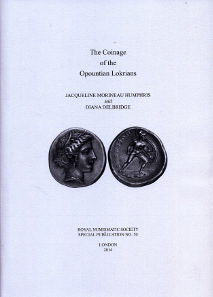von Ursula Kampmann
translated by Annika Backe
March 5, 2015 – What is the exact location of Lokroi Opontioi? What is it after all? A city? A tribe? Ask the numismatists and you will find that hardly any of them knows the answer to this. Yet the most enchanting coins are offered under this very label. So what is it with this coinage that depicts the head of Demeter on the obverse and fighting Ajax on the reverse?
Jacqueline Morineau Humphris, Diana Delbridge, The Coinage of the Opountian Lokrians. Spink, London, 2014. 261 p., 22 x 30,4 cm, fig. in black and white; 61 pl., Hardcover. ISBN: 0-901405-74-4. £60.
The author duo Jacqueline Morineau Humphris and Diana Delbridge have dealt with this topic. They feel sympathy for the reader in that they reveal the location of the ancient city of Opous already in the introduction. This information is very useful and leads over to the following chapter, the history of the Lokrians living in the city of Opous.
You need to know that the Lokrians of the Opous region were not the only ones bearing this name. There were other groups as well, identified by their different epithets which are almost buried into oblivion today. Or have you ever heard of the Ozolian and the Epicnemedian Lokrians? In the first chapter, the two authors examine the limited number of extant sources and successfully revive this tribe which the ancient writers more or less treat like an orphan.
The writing style of this chapter deserves special emphasis. No rhetorical capers obscure the picture which makes the facts easy to comprehend, and this is something every reader will appreciate.
A few chapters as a basis for the interpretation of the coinage follow next: the cults of Opous and the various forms of ethnic are elaborated on. Starting on page 23, it is all about coinage then. Firstly, the authors discuss the minting date of the various groups of coins. They are very likely to drive more than one catalog author mad because they do not give a time span that could be copied and pasted but rather force their reader to follow them on the devious routes of dating by studying hoards and drawing comparisons. Naturally, this is a much more honest approach than the seemingly fixed dates the numismatic catalogs of the past provided their readers with. But seriously, what is a non-academic, who surely likewise wants to read this book, to make of something like the following sentence: ‘like group 2, group 3’s first appearances in hoards are in the Atrax hoard, c. 340.’
It is not for nothing that many coin dealers keep copying the completely obsolete dates of Michael Crawford simply because this doesn’t require much time or thinking. Revising an obsolete date likewise means processing it in such a way that a user in a hurry can easily find, comprehend and quote it. The authors seem to leave an important target audience out that will certainly buy the majority of copies.
The catalog is a die-study of all series, with discussion, accessed specimens and illustrations treated separately. The authors went to great lengths and included all specimens available on the market as well. It is pity that the reader has to look in three different places to collect all the relevant information.
It is a prerogative of the critic, though, to turn the attention to minor details in a monograph that impresses with the sheer quantity of material collected and accessed. This book is going to be a reference work for everybody aiming at a proper identification of the coinage of the Opountian Lokrians. After reading this book, surely no one will still be at a loss as to what to make of Lokroi Opontioi.
You can place an order for this impressive monograph, a special publication published by the
Royal Numismatic Society, with Spink.





